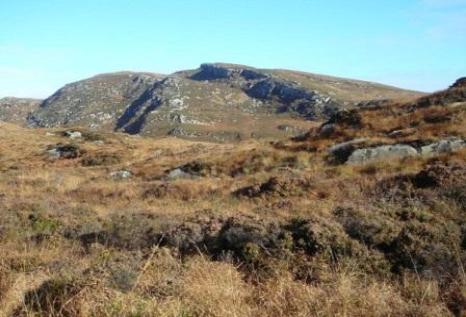
Barnes Gap
Take a look at a physical map of Donegal which shows the mountains and rivers, and note the size of the brown area in the middle, made up of the Derryveaghs and Bluestacks and the highlands in between. Most of us travel along the main roads which cut through these uplands and, although we might admire the scenery, we rarely take off along a side road or a rushy track to discover what lies around the next corner.
Recent years have seen big changes, with huge acreages of forestry plantation and the arrival of wind farms, but there are still wide stretches of wonderful wide wilderness, uncut blanket bog and heathery hillside, where you can finally shake off the noise of traffic and tune in to the sound of silence.
There have been big efforts to set up marked walking trails to make the uplands more accessible, and hill walking groups are getting very popular. Information and guide books can be had at tourist offices, and the Ordnance Survey Discovery Maps show miles of mountain track and “green road” marked by dotted lines which are well worth exploring.
Birdlife in the hills can seem very sparse, but there’s always a good chance of hearing the deep hollow croak that announces the presence of a Raven. At over two-feet long, this is the largest of the Crow family, with heavy beak and shaggy throat feathers and characteristic diamond-shaped tail. It’s about the size of a Barnacle Goose. Ravens breed early in the year so this is a good time to look out for the male’s spectacular courtship display as he shows off his flying skills to his mate. He glides and soars high in the sky, swooping down with angled wings, diving and tumbling and even flipping upside-down. He looks as if he is really enjoying himself, and the females seem to be suitably impressed for they usually mate for life. Adult birds don’t move far from their breeding territory, summer or winter, and can hold on to the same patch for several decades.
The wide open spaces of the uplands are also where you stand a fair chance of spotting birds of prey. The Merlin is the smallest one, not much larger than a Blackbird, and fairly scarce, but one of its strongholds is in the Donegal hills. It chases small birds at high speed across open ground, following every twist and turn and catching them on the wing. The Kestrel has a different hunting technique, hovering high above prey on the ground, with head and body held motionless between quivering wings. It can often catch its victim with one swoop. But the champion sky-diver is the Peregrine which can reach speeds of 200 miles per hour as it drops on its prey, taking it in mid-air with one clenched talon. It’s reckoned to be the fastest creature in the world.
Buzzards and Sparrowhawks are more frequent in lowland areas, although Buzzards have now re-colonised most of Donegal after being absent for about a century, so you can meet one almost anywhere. These are large birds with a wingdiv of over a metre and people often mistake them for Eagles. But Eagles are in a different league again – about four times as heavy as a Buzzard and with a two-metre wingdiv. With the ongoing success of the Golden Eagle Reintroduction Project at Glenveagh over the last ten years, it’s great to know that we can now watch out again for these magnificent birds sailing over the mountain tops.
Winter is the best time for noticing mosses. With our mild moist climate we have about 400 different species and they turn up everywhere, from the tops of mountains to suburban gardens. Every habitat has its own collection, and in upland areas you can find a rich profusion on blanket bogs and also in the remnants of woodland in rocky gorges, where they form thick cushions on the rocks and tree trunks. The constant misty spray from falling water is ideal for them, and some very scarce and choosy ones are found only around large mountain waterfalls.
Mosses are worth a closer look, especially with a hand-lens or magnifying glass, for they come in a wonderful variety of textures and designs. Pull out a frond and you’re looking at a complete plant. Some of them are neat and symmetrical while others are loose and free. Some are covered with silvery spikes and others with braids of golden hair. Many are so thin-skinned that they appear to be filled with light. In a natural woodland the thick mossy blanket acts as an enormous sponge, soaking up the rainfall, which is one reason why clearing forests on hillsides can lead to serious flooding.
Four to Find this Month:Fieldfare & Redwing: winter visitors from Northern Europe which are members of the Thrush family. They have the familiar speckled breast of our resident Thrushes, but their brighter plumages make them fairly easy to pick out in a mixed flock – blue-grey hood and chestnut back on the Fieldfare, and red flanks and underwings on the Redwing. |